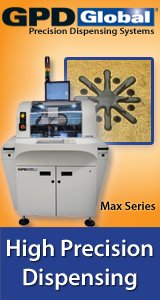Printed Circuit Board Assembly & PCB Design Forum
SMT electronics assembly manufacturing forum.
- SMTnet
- »
- Electronics Forum
- »
- Universal Instruments Radial Inserter
Universal Instruments Radial Inserter
Views: 10668
![]() We just obtained a Radial 5 Inserter with no
documentation...
- Jul 19, 2007
by
gmoritz
We just obtained a Radial 5 Inserter with no
documentation...
- Jul 19, 2007
by
gmoritz
![]()
![]()
![]() Did you buy this from an equipment dealer or an end user?
...
- Jul 19, 2007
by
jdengler
Did you buy this from an equipment dealer or an end user?
...
- Jul 19, 2007
by
jdengler
![]()
![]()
![]() Radial Leads (I've had IIs, IIIs, and Vs) do the job nicely,...
- Jul 19, 2007
by
Steve Thomas
Radial Leads (I've had IIs, IIIs, and Vs) do the job nicely,...
- Jul 19, 2007
by
Steve Thomas
![]()
![]()
![]() > If you bought it from an equipment dealer ...
OK, the d...
- Jul 20, 2007
by
gmoritz
> If you bought it from an equipment dealer ...
OK, the d...
- Jul 20, 2007
by
gmoritz
![]()
![]()
![]() Invest in some training.
...
- Jul 20, 2007
by
Fastek
Invest in some training.
...
- Jul 20, 2007
by
Fastek
![]()
![]()
![]() (1) part standoff - how far the base of the part
rests fro...
- Jul 23, 2007
by
Steve Thomas
(1) part standoff - how far the base of the part
rests fro...
- Jul 23, 2007
by
Steve Thomas
![]()
![]()
![]() Steve Thomas:
Thank you for the well-written, helpful exp...
- Jul 23, 2007
by
gmoritz
Steve Thomas:
Thank you for the well-written, helpful exp...
- Jul 23, 2007
by
gmoritz
![]()
![]()
![]() "This might have an effect on failed clinch/cuts when
the ...
- Jul 23, 2007
by
Steve Thomas
"This might have an effect on failed clinch/cuts when
the ...
- Jul 23, 2007
by
Steve Thomas
![]()
![]()
![]() > Have you tried running it in step mode?
Yes, and more. ...
- Jul 23, 2007
by
gmoritz
> Have you tried running it in step mode?
Yes, and more. ...
- Jul 23, 2007
by
gmoritz
![]()
![]()
![]() Sorry guy.........just trying to state the obvious is all.
...
- Jul 23, 2007
by
Fastek
Sorry guy.........just trying to state the obvious is all.
...
- Jul 23, 2007
by
Fastek
![]()
![]()
![]() I have to agree with Fastek on the issue of having someone w...
- Jul 24, 2007
by
vikkaraja
I have to agree with Fastek on the issue of having someone w...
- Jul 24, 2007
by
vikkaraja
![]()
![]()
![]() If you have'nt had the pleasure of working on these machines...
- Jul 27, 2007
by
jeffharley
If you have'nt had the pleasure of working on these machines...
- Jul 27, 2007
by
jeffharley
![]()
![]()
![]() I'm posting a diary of the major repair experience that we h...
- Jul 30, 2007
by
gmoritz
I'm posting a diary of the major repair experience that we h...
- Jul 30, 2007
by
gmoritz
![]()
![]()
![]() I'll respond to this one since it is the most poignant
post...
- Jul 30, 2007
by
gmoritz
I'll respond to this one since it is the most poignant
post...
- Jul 30, 2007
by
gmoritz
![]()
![]()
![]() If you can, put a pressure tank near the machine.
It will h...
- Jul 31, 2007
by
Stephen
If you can, put a pressure tank near the machine.
It will h...
- Jul 31, 2007
by
Stephen
![]()
![]()
![]() We've had some experience with Universal's machines as well....
- Aug 02, 2007
by
John S.
We've had some experience with Universal's machines as well....
- Aug 02, 2007
by
John S.
![]()
![]()
![]() Any experience with the encoders and ball screws that drive ...
- Aug 03, 2007
by
gmoritz
Any experience with the encoders and ball screws that drive ...
- Aug 03, 2007
by
gmoritz
![]()
![]()
![]() You probably do not have "Drift". The rotary table and or f...
- Aug 03, 2007
by
jdengler
You probably do not have "Drift". The rotary table and or f...
- Aug 03, 2007
by
jdengler
![]()
![]()
![]() I agree with jdengler on the rotary table being skewed. You ...
- Aug 06, 2007
by
Steve Thomas
I agree with jdengler on the rotary table being skewed. You ...
- Aug 06, 2007
by
Steve Thomas
![]()
![]()
![]() > Do you have BEC (Board Error Correction)
> on that machi...
- Aug 06, 2007
by
gmoritz
> Do you have BEC (Board Error Correction)
> on that machi...
- Aug 06, 2007
by
gmoritz
![]()
![]()
![]() BEC hardware would be on the machine as a sensor underneath ...
- Aug 06, 2007
by
Steve Thomas
BEC hardware would be on the machine as a sensor underneath ...
- Aug 06, 2007
by
Steve Thomas
![]()
![]()
![]() Slot 11 in the I/O box is the one for B.E.C. pcb, the offset...
- Aug 13, 2007
by
jeffharley
Slot 11 in the I/O box is the one for B.E.C. pcb, the offset...
- Aug 13, 2007
by
jeffharley
![]()
![]()
![]() I'm updating this thread and replying to the first post in
...
- Aug 27, 2007
by
gmoritz
I'm updating this thread and replying to the first post in
...
- Aug 27, 2007
by
gmoritz
![]()
- SMTnet
- »
- Electronics Forum
- »
- Universal Instruments Radial Inserter







